Deformation Behavior of β Phase in a WE54 Magnesium Alloy
Abstract
:1. Introduction
2. Materials and Methods
3. Results and Discussion
4. Conclusions
- The prepared alloy with submicron intergranular β phases and fine α-Mg grains had superior mechanical properties (YS ~240 MPa and elongation ~16%).
- The β phases acted as hard phases and showed an effective load-transfer effect.
- The microstrain of the β phases quickly increased before 2% plastic strain, which can be ascribed to the rapid stress concentration at the β/α-Mg interface.
- After ~6.5% plastic strain, the ability to hurdle the dislocation movement by β phases reached its limitation, and the stress concentration near the β/α-Mg interface was partly relieved, which helped develop the good ductility of the material.
Author Contributions
Funding
Institutional Review Board Statement
Informed Consent Statement
Data Availability Statement
Acknowledgments
Conflicts of Interest
References
- Sun, W.; Wu, B.; Fu, H.; Yang, X.-S.; Qiao, X.; Zheng, M.; He, Y.; Lu, J.; Shi, S.-Q. Combining gradient structure and supersaturated solid solution to achieve superior mechanical properties in WE43 magnesium alloy. J. Mater. Sci. Technol. 2022, 99, 223–238. [Google Scholar] [CrossRef]
- Yu, Z.; Huang, Y.; Liu, L.; Shi, K.; Du, B.; Liu, K.; Li, S.; Du, W. New strategy to solve the ambient strength-ductility dilemma in precipitation-strengthened Mg-Gd alloys via Li addition. Scr. Mater. 2022, 220, 114901. [Google Scholar] [CrossRef]
- Nie, J.F. Precipitation and hardening in magnesium alloys. Metall. Mater. Trans. A 2012, 43A, 3891–3939. [Google Scholar] [CrossRef]
- Apps, P.J.; Karimzadeh, H.; King, J.F.; Lorimer, G.W. Precipitation reactions in Magnesium-rare earth alloys containing Yttrium, Gadolinium or Dysprosium. Scr. Mater. 2003, 48, 1023–1028. [Google Scholar] [CrossRef]
- Zhu, Q.; Li, Y.; Ding, Z.; Wang, J.; Liu, Y.; Zhang, H.; Xie, T.; Wang, M.; Zhu, H.; Ying, T.; et al. Unveiling precipitation behavior in Mg-Y based alloys. Mater. Des. 2021, 202, 109570. [Google Scholar] [CrossRef]
- Nie, J.F.; Wilson, N.C.; Zhu, Y.M.; Xu, Z. Solute clusters and GP zones in binary Mg-RE alloys. Acta Mater. 2016, 106, 260–271. [Google Scholar] [CrossRef]
- Easton, M.A.; Gibson, M.A.; Qiu, D.; Zhu, S.M.; Gröbner, J.; Schmid-Fetzer, R.; Nie, J.F.; Zhang, M.X. The role of crystallography and thermodynamics on phase selection in binary magnesium–rare earth (Ce or Nd) alloys. Acta Mater. 2012, 60, 4420–4430. [Google Scholar] [CrossRef]
- Li, R.G.; Li, H.R.; Pan, H.C.; Xie, D.S.; Zhang, J.H.; Fang, D.Q.; Dai, Y.Q.; Zhao, D.Y.; Zhang, H. Achieving exceptionally high strength in binary Mg-13Gd alloy by strong texture and substantial precipitates. Scr. Mater. 2021, 193, 142–146. [Google Scholar] [CrossRef]
- Nie, J.F.; Muddle, B.C. Characterisation of strengthening precipitate phases in a Mg–Y–Nd alloy. Acta Mater. 2000, 48, 1691–1703. [Google Scholar] [CrossRef]
- Sun, W.; He, Y.; Qiao, X.; Zhao, X.; Chen, H.; Gao, N.; Starink, M.J.; Zheng, M. Exceptional thermal stability and enhanced hardness in a nanostructured Mg-Gd-Y-Zn-Zr alloy processed by high pressure torsion. J. Magnes. Alloy, 2022; in press. [Google Scholar] [CrossRef]
- Liu, K.; Wang, X.; Du, W. Development of extraordinary high-strength-toughness Mg alloy via combined processes of repeated plastic working and hot extrusion. Mater. Sci. Eng. A 2013, 573, 127–131. [Google Scholar] [CrossRef]
- Zheng, X.; Du, W.; Wang, Z.; Li, S.; Liu, K.; Du, X. Remarkably enhanced mechanical properties of Mg-8Gd-1Er-0.5Zr alloy on the route of extrusion, rolling and aging. Mater. Lett. 2018, 212, 155–158. [Google Scholar] [CrossRef]
- Cabibbo, M.; Paoletti, C.; Minárik, P.; Král, R.; Zemková, M. Secondary phase precipitation and thermally stable microstructure refinement induced by ECAP on Mg-Y-Nd (WN43) alloy. Mater. Lett. 2019, 237, 5–8. [Google Scholar] [CrossRef]
- Lentz, M.; Klaus, M.; Wagner, M.; Fahrenson, C.; Beyerlein, I.J.; Zecevic, M.; Reimers, W.; Knezevic, M. Effect of age hardening on the deformation behavior of an Mg-Y-Nd alloy: In-situ X-ray diffraction and crystal plasticity modeling. Mater. Sci. Eng. A 2015, 628, 396–409. [Google Scholar] [CrossRef]
- Kada, S.R.; Lynch, P.A.; Kimpton, J.A.; Barnett, M.R. In-situ X-ray diffraction studies of slip and twinning in the presence of precipitates in AZ91 alloy. Acta Mater. 2016, 119, 145–156. [Google Scholar] [CrossRef]
- Zhou, B.; Wang, L.; Chen, B.; Jia, Y.; Wen, W.; Li, D.; Shu, D.; Jin, P.; Zeng, X.; Ding, W. Study of age hardening in a Mg–2.2 wt%Nd alloy by in situ synchrotron X-ray diffraction and mechanical tests. Mater. Sci. Eng. A 2017, 708, 319–328. [Google Scholar] [CrossRef]
- Garces, G.; Medina, J.; Pérez, P.; Máthis, K.; Horváth, K.; Stark, A.; Schell, N.; Adeva, P. Influence of quasicrystal I-phase on twinning of extruded Mg-Zn-Y alloys under compression. Acta Mater. 2018, 151, 271–281. [Google Scholar] [CrossRef]
- Sarvesha, R.; Chalapathi, D.; Yadava, M.; Jain, J.; Singh, S.S. In-situ studies on deformation and fracture characteristics of AZ91 Mg alloy. Materialia 2021, 18, 101177. [Google Scholar] [CrossRef]
- Zhou, B.; Wang, L.; Zhu, G.; Wang, J.; Wen, W.; Zeng, X. Understanding the strengthening effect of β1 precipitates in Mg-Nd using in situ synchrotron X-ray diffraction. JOM 2018, 70, 2315–2320. [Google Scholar] [CrossRef]
- Zhou, B.; Wang, L.; Wang, J.; Maldar, A.; Zhu, G.; Jia, H.; Jin, P.; Zeng, X.; Li, Y. Dislocation behavior in a polycrystalline Mg-Y alloy using multi-scale characterization and VPSC simulation. J. Mater. Sci. Technol. 2022, 98, 87–98. [Google Scholar] [CrossRef]
- Zhou, B.; Li, Y.; Wang, L.; Jia, H.; Zeng, X. The role of grain boundary plane in slip transfer during deformation of magnesium alloys. Acta Mater. 2022, 227, 117662. [Google Scholar] [CrossRef]
- Zhang, D.; Wang, L.; Zhang, H.; Maldar, A.; Zhu, G.; Chen, W.; Park, J.-S.; Wang, J.; Zeng, X. Effect of heat treatment on the tensile behavior of selective laser melted Ti-6Al-4V by in situ X-ray characterization. Acta Mater. 2020, 189, 93–104. [Google Scholar] [CrossRef]
- Williamson, G.K.; Hall, W.H. X-ray line broadening from filed aluminium and wolfram. Acta Metall. 1953, 1, 22–31. [Google Scholar] [CrossRef]
- Seymour, T.; Frankel, P.; Balogh, L.; Ungár, T.; Thompson, S.P.; Jädernäs, D.; Romero, J.; Hallstadius, L.; Daymond, M.R.; Ribárik, G.; et al. Evolution of dislocation structure in neutron irradiated Zircaloy-2 studied by synchrotron x-ray diffraction peak profile analysis. Acta Mater. 2017, 126, 102–113. [Google Scholar] [CrossRef]
- Li, X.; Liu, C.; Wang, J.; Zhang, C. Tailoring the strength and formability of Mg alloys through rare earth element additions (Gd and Dy) and dynamic recrystallizations. Mater. Today Commun. 2021, 28, 102627. [Google Scholar] [CrossRef]
- He, C.; Zhu, H.; Yuan, M.; Jiang, B.; Wang, Q.; Chai, Y.; Huang, G.; Zhang, D.; Pan, F. Comparison of room-temperature stretch formability of the as extruded Mg–Gd alloys with different double-peak pole spacing. J. Mater. Res. Technol. 2021, 15, 4838–4851. [Google Scholar] [CrossRef]
- Mansoor, A.; Du, W.; Yu, Z.; Ding, N.; Fu, J.; Lou, F.; Liu, K.; Li, S. Effects of grain refinement and precipitate strengthening on mechanical properties of double-extruded Mg-12Gd-2Er-0.4Zr alloy. J. Alloys Compd. 2022, 898, 162873. [Google Scholar] [CrossRef]
- Mansoor, A.; Du, W.; Yu, Z.; Liu, K.; Ding, N.; Fu, J.; Lou, F.; Li, S. Improved mechanical performance of double-pass extruded Mg-Gd-Er-Zr alloys with various rare earth contents. Mater. Sci. Eng. A 2022, 840, 142922. [Google Scholar] [CrossRef]
- Xu, Z.; Weyland, M.; Nie, J.F. On the strain accommodation of β1 precipitates in magnesium alloy WE54. Acta Mater. 2014, 75, 122–133. [Google Scholar] [CrossRef]
- Li, R.G.; Song, P.F.; Wu, G.L.; Liu, B.S.; Pan, H.C.; Li, J.R.; Zhang, H. Tensile yielding plateau in fine-grained Mg-15Gd binary alloy. Mater. Lett. 2022, 324, 132757. [Google Scholar] [CrossRef]
- Maier, P.; Lauth, N.; Mendis, C.L.; Bechly, M.; Hort, N. Mechanical and corrosion properties of two precipitation-hardened Mg-Y-Nd-Gd-Dy alloys with small changes in chemical composition. JOM 2019, 71, 1426–1435. [Google Scholar] [CrossRef]
- Sheng, L.Y.; Du, B.N.; Wang, B.J.; Xu, D.K.; Lai, C.; Gao, Y.; Xi, T.F. Hot extrusion effect on the microstructure and mechanical properties of a Mg–Y–Nd–Zr alloy. Strength Mater. 2018, 50, 184–192. [Google Scholar] [CrossRef]
- Lentz, M.; Klaus, M.; Coelho, R.S.; Schaefer, N.; Schmack, F.; Reimers, W.; Clausen, B. Analysis of the deformation behavior of magnesium-rare earth alloys Mg-2 pct Mn-1 pct rare earth and Mg-5 pct Y-4 pct rare earth by in situ energy-dispersive X-ray synchrotron diffraction and elasto-plastic self-consistent modeling. Metall. Mater. Trans. A 2014, 45, 5721–5735. [Google Scholar] [CrossRef]
- Asqardoust, S.; Zarei Hanzaki, A.; Abedi, H.R.; Krajnak, T.; Minárik, P. Enhancing the strength and ductility in accumulative back extruded WE43 magnesium alloy through achieving bimodal grain size distribution and texture weakening. Mater. Sci. Eng. A 2017, 698, 218–229. [Google Scholar] [CrossRef]
- Jamili, A.M.; Zarei-Hanzaki, A.; Abedi, H.R.; Minárik, P.; Soltani, R. The microstructure, texture, and room temperature mechanical properties of friction stir processed Mg-Y-Nd alloy. Mater. Sci. Eng. A 2017, 690, 244–253. [Google Scholar] [CrossRef]
- Zhou, X.; Li, J.; Wu, P.; Yi, S.; Ge, H. Effect of aggressive ions on degradation of WE43 magnesium alloy in physiological environment. Int. J. Electrochem. Sci. 2014, 9, 304–314. [Google Scholar]
- Zhang, X.; Yuan, G.; Mao, L.; Niu, J.; Ding, W. Biocorrosion properties of as-extruded Mg–Nd–Zn–Zr alloy compared with commercial AZ31 and WE43 alloys. Mater. Lett. 2012, 66, 209–211. [Google Scholar] [CrossRef]
- Dvorský, D.; Kubásek, J.; Voňavková, I.; Vojtěch, D. Structure, mechanical and corrosion properties of extruded Mg-Nd-Zn, Mg-Y-Zn and Mg-Y-Nd alloys. Mater. Sci. Technol. 2019, 35, 520–529. [Google Scholar] [CrossRef]
- Wang, J.; Wang, L.; Zhu, G.; Zhou, B.; Ying, T.; Zhang, X.; Huang, Q.; Shen, Y.; Zeng, X.; Jiang, H. Understanding the High Strength and Good Ductility in LPSO-Containing Mg Alloy Using Synchrotron X-ray Diffraction. Metall. Mater. Trans. A 2018, 49, 5382–5392. [Google Scholar] [CrossRef]
- Daymond, M.R. The determination of a continuum mechanics equivalent elastic strain from the analysis of multiple diffraction peaks. J. Appl. Phys. 2004, 96, 4263–4272. [Google Scholar] [CrossRef]
- Guo, Y.; Britton, T.B.; Wilkinson, A.J. Slip band–grain boundary interactions in commercial-purity titanium. Acta Mater. 2014, 76, 1–12. [Google Scholar] [CrossRef]
- Bhattacharyya, J.J.; Wang, F.; Stanford, N.; Agnew, S.R. Slip mode dependency of dislocation shearing and looping of precipitates in Mg alloy WE43. Acta Mater. 2018, 146, 55–62. [Google Scholar] [CrossRef]
- Solomon, E.L.S.; Marquis, E.A. Deformation behavior of β′ and β′′′ precipitates in Mg-RE alloys. Mater. Lett. 2018, 216, 67–69. [Google Scholar] [CrossRef]
- Guo, Y.; Liu, B.; Xie, W.; Luo, Q.; Li, Q. Anti-phase boundary energy of β series precipitates in Mg-Y-Nd system. Scr. Mater. 2021, 193, 127–131. [Google Scholar] [CrossRef]
- Kula, A.; Jia, X.; Mishra, R.K.; Niewczas, M. Flow stress and work hardening of Mg-Y alloys. Int. J. Plast. 2017, 92, 96–121. [Google Scholar] [CrossRef]
- Zhu, G.; Wang, L.; Wang, J.; Wang, J.; Park, J.-S.; Zeng, X. Highly deformable Mg-Al-Ca alloy with Al2Ca precipitates. Acta Mater. 2020, 200, 236–245. [Google Scholar] [CrossRef]
- Nie, J.F. Effects of precipitate shape and orientation on dispersion strengthening in magnesium alloys. Scr. Mater. 2003, 48, 1009–1015. [Google Scholar] [CrossRef]
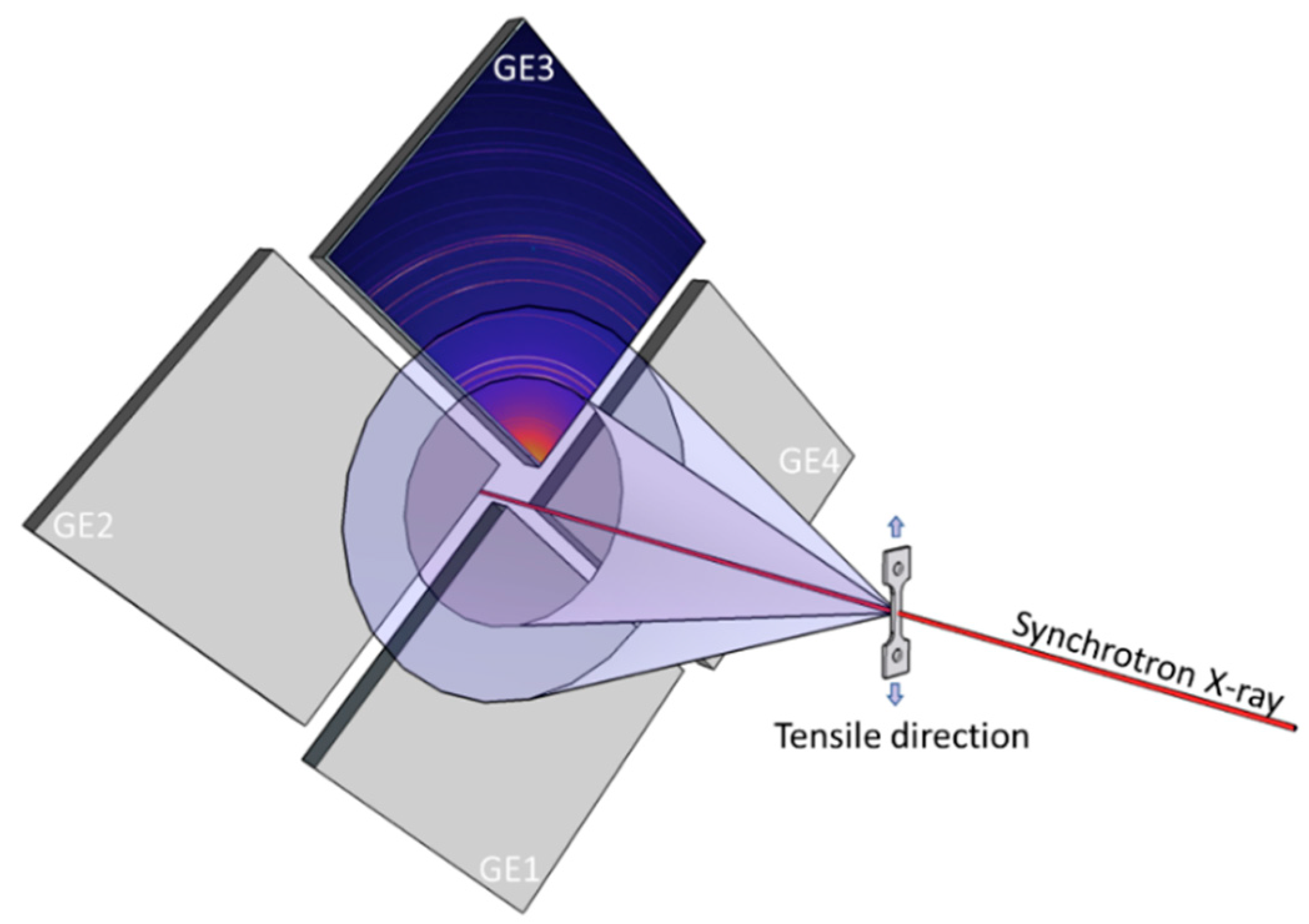
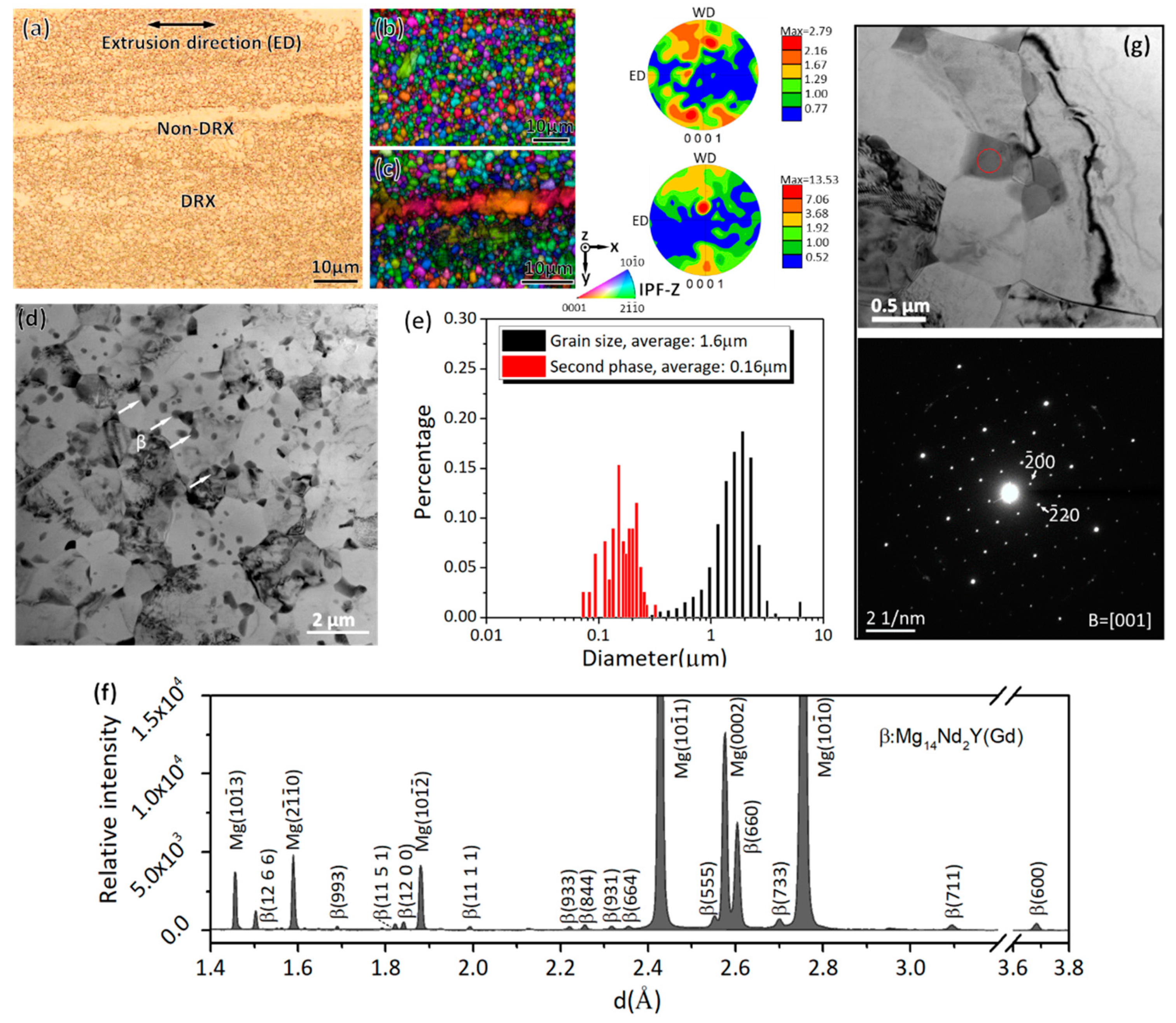
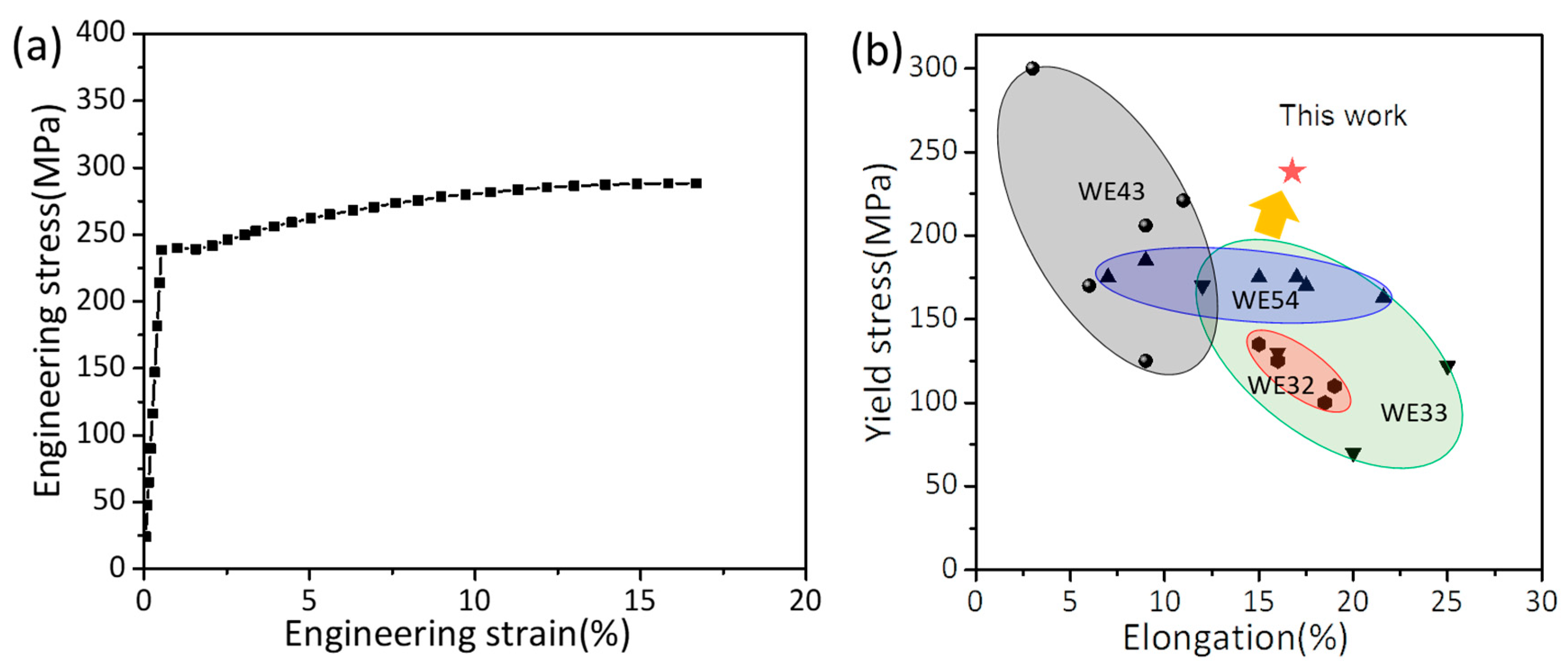


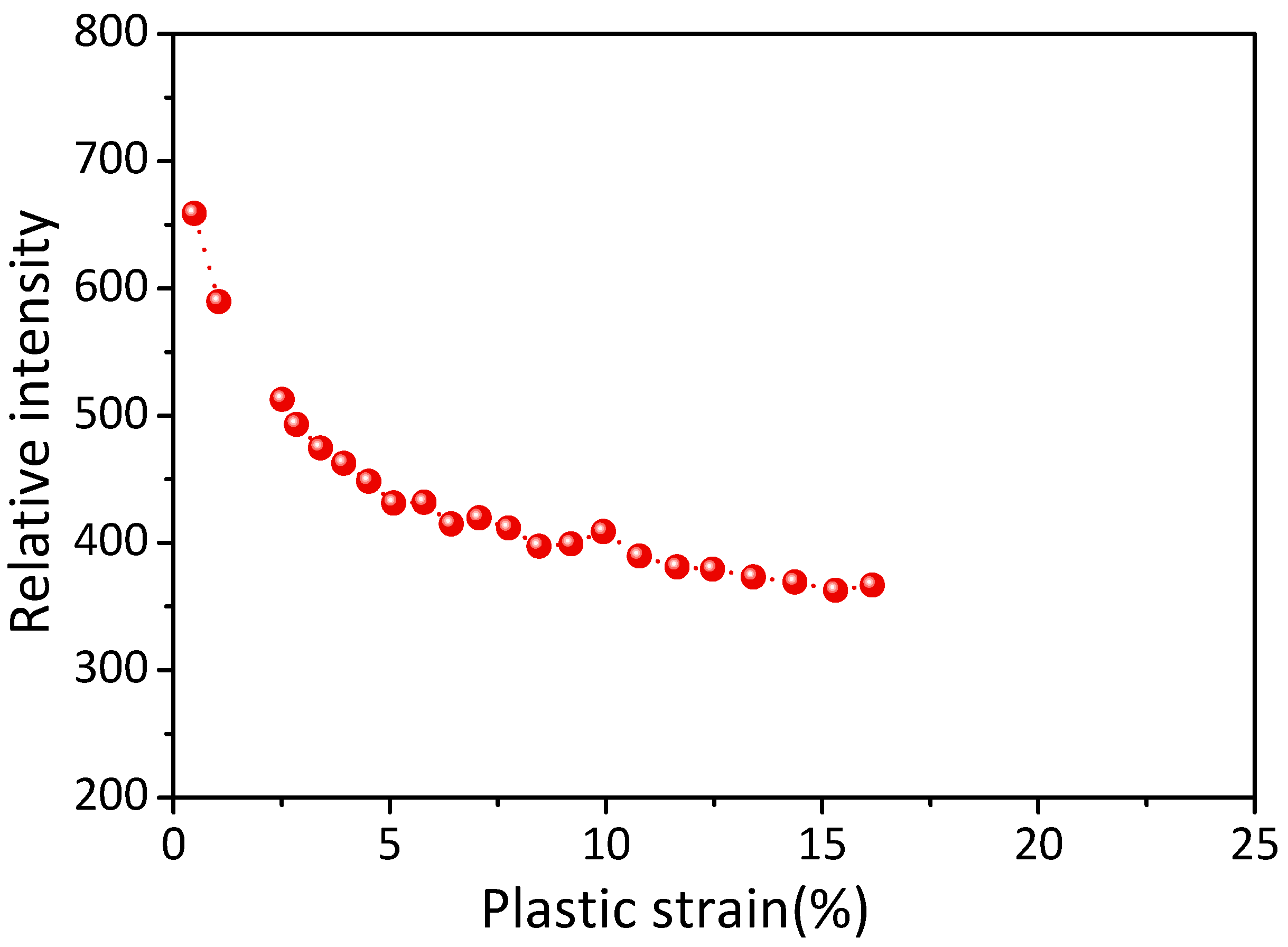
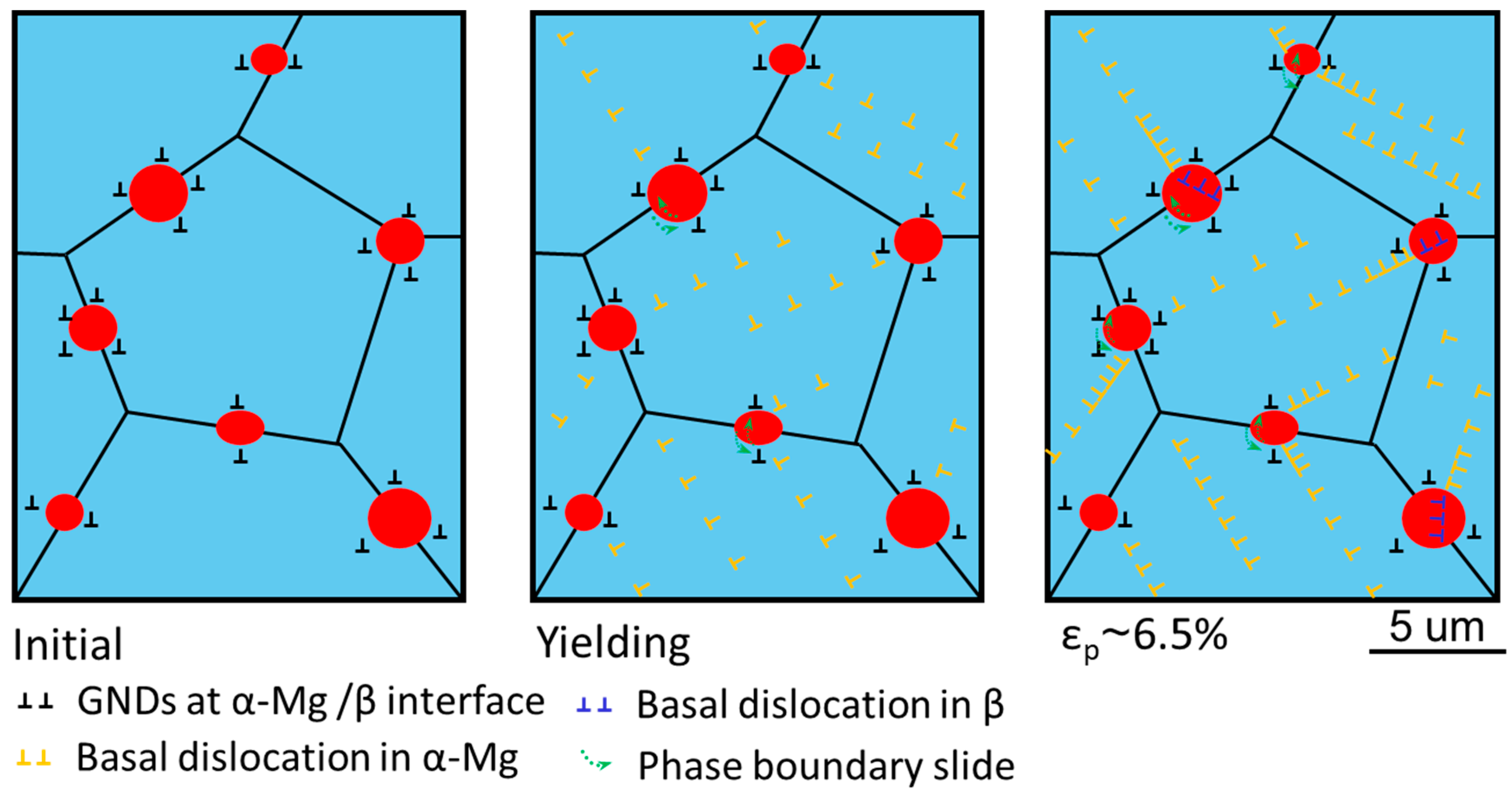
Disclaimer/Publisher’s Note: The statements, opinions and data contained in all publications are solely those of the individual author(s) and contributor(s) and not of MDPI and/or the editor(s). MDPI and/or the editor(s) disclaim responsibility for any injury to people or property resulting from any ideas, methods, instructions or products referred to in the content. |
© 2023 by the authors. Licensee MDPI, Basel, Switzerland. This article is an open access article distributed under the terms and conditions of the Creative Commons Attribution (CC BY) license (https://creativecommons.org/licenses/by/4.0/).
Share and Cite
Zhou, B.; Wang, J.; Jia, H.; Hao, T.; Ma, Z.; Wang, L.; Zeng, X. Deformation Behavior of β Phase in a WE54 Magnesium Alloy. Materials 2023, 16, 1513. https://doi.org/10.3390/ma16041513
Zhou B, Wang J, Jia H, Hao T, Ma Z, Wang L, Zeng X. Deformation Behavior of β Phase in a WE54 Magnesium Alloy. Materials. 2023; 16(4):1513. https://doi.org/10.3390/ma16041513
Chicago/Turabian StyleZhou, Bijin, Jie Wang, Hailong Jia, Ting Hao, Zhenwu Ma, Leyun Wang, and Xiaoqin Zeng. 2023. "Deformation Behavior of β Phase in a WE54 Magnesium Alloy" Materials 16, no. 4: 1513. https://doi.org/10.3390/ma16041513
APA StyleZhou, B., Wang, J., Jia, H., Hao, T., Ma, Z., Wang, L., & Zeng, X. (2023). Deformation Behavior of β Phase in a WE54 Magnesium Alloy. Materials, 16(4), 1513. https://doi.org/10.3390/ma16041513







